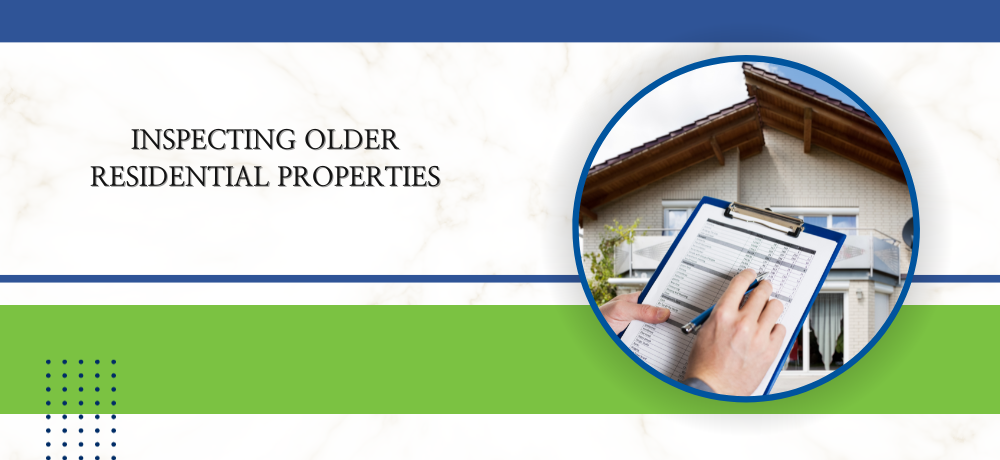
Inspecting Older Residential Properties
- Summit Property Inspectors
Nestled among modern marvels and contemporary dwellings, older residential properties stand as timeless witnesses to the rich tapestry of architectural history. These venerable structures exude a charm and character that transcends the ages, but behind their historic facades lie unique challenges and considerations for those seeking to inspect and potentially invest in these time-honored homes.
In this blog, we'll explore the nuances of inspecting homes with a few years under their belt and how a thorough inspection can uncover valuable insights for homeowners or potential buyers.
Foundation and Structural Integrity:
Start the inspection by meticulously examining the foundation of the older residential property. Look for any visible cracks, both on the exterior and interior walls, as well as the foundation itself. Vertical cracks might be indicative of settling, while horizontal cracks may suggest more severe structural issues. Take note of any uneven floors, as this can be a sign of foundation problems, potentially requiring professional assessment and repair. Additionally, inspect the basement for signs of water intrusion or dampness, as persistent moisture can compromise the structural integrity over time.
Electrical System:
Thoroughly assess the electrical wiring throughout the older home. In particular, pay attention to the type of wiring used, as outdated materials may pose safety hazards. Inspect the circuit breaker panel for its age and functionality, ensuring it can adequately handle the electrical load of modern appliances and technology. In older properties, there might be a presence of knob-and-tube wiring or aluminum wiring, both of which can pose safety concerns. Consider consulting with an electrician to evaluate the need for updates or replacements to meet current safety standards.
Plumbing System:
Evaluate the plumbing system for any signs of wear and tear, especially in older homes where outdated materials may be present. Check for leaks, corrosion, or rust in pipes, and pay special attention to the condition of supply lines and drainage pipes. Galvanized pipes, commonly used in older homes, may corrode over time, leading to reduced water pressure and potential leaks. Inspect bathrooms and kitchens for signs of water damage around sinks, toilets, and bathtubs, as these areas are more prone to plumbing issues.
Roofing and Attic Space:
Conduct a detailed examination of the roof to identify any missing or damaged shingles, as well as signs of wear. Pay attention to the age of the roofing material, as older roofs may be more susceptible to deterioration. Inspect the attic for proper ventilation and insulation. Inadequate ventilation can lead to moisture problems, potentially causing rot or mold. Verify the condition of insulation to ensure it meets current energy efficiency standards. Addressing roofing and attic issues promptly can prevent more extensive damage to the structure and enhance energy efficiency.
HVAC System:
Assess the heating, ventilation, and air conditioning (HVAC) system to ensure it is operating efficiently. Older homes may have outdated HVAC systems that lack modern energy-saving features. Verify the condition of the furnace, air conditioner, and ductwork. Check air filters and ensure they are regularly replaced for optimal performance. Evaluate the HVAC system's overall capacity to meet the home's heating and cooling needs. Consider consulting with an HVAC professional to determine if any upgrades or replacements are necessary to improve energy efficiency and indoor comfort.
Environmental Concerns:
Addressing environmental concerns is crucial in older residential properties. Test for lead-based paint, a common feature in homes built before 1978. If present, proper remediation or encapsulation should be undertaken by certified professionals to mitigate health risks, especially for children and pregnant individuals. Similarly, assess the presence of asbestos in insulation, flooring, or ceiling tiles and take appropriate measures for safe removal or containment. Additionally, conduct radon testing, as older homes may be more susceptible to radon gas infiltration. Radon, a naturally occurring radioactive gas, can pose serious health risks, and mitigation measures may be necessary if elevated levels are detected.
Inspecting older residential properties requires a holistic approach that considers the balance between preserving historical charm and ensuring structural integrity. By addressing upgrades, energy efficiency, landscaping, and maintenance, homeowners can enjoy the best of both worlds.
Get in touch with Summit Property Inspectors today! To learn more about what we do, please click here. To contact us, please click here or call us at (718) 720-5512.
